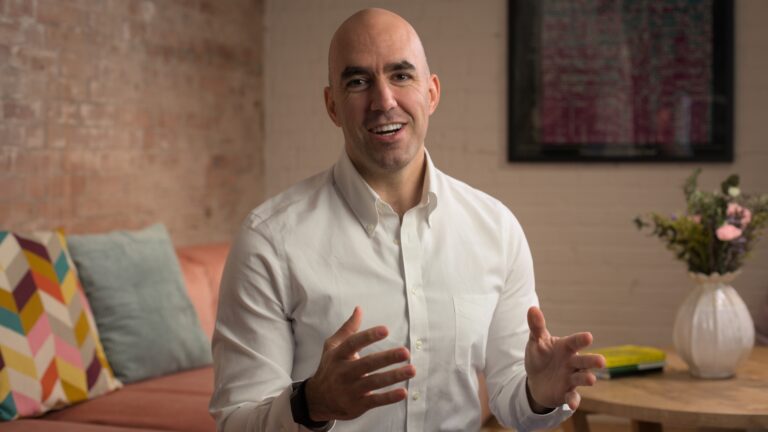Season 5: Innovating for impact
A clear vision for business success

“The best way to predict the future is to create it.”
Peter Drucker, management consultant
In this part, we will explore the importance of having a clear vision for your business, share techniques and tools for crafting a compelling vision, and highlight the benefits of having a well-defined vision for your future success.
What is a vision?
A vision refers to a desired state or an aspirational destination for an organization or person. A vision is usually the idea of a far-off future and requires long-term thinking, imagination and creativity. And it resides in the hearts and minds of the people who created it.
Why vision is essential for business
A vision is a statement about the future that a business can commit to over time.
It creates an unbreakable bond between the present and the future, acting as a guiding light about tomorrow that positively affects the decisions you make today. It helps you pick the suppliers and partners you want to work with, to recruit the right people for your organisation, and it articulates to consumers where you are heading and why. In essence, it can provide a powerful and purposeful commitment to a specific future direction.
By investing time, effort and creativity into crafting and communicating a compelling vision, businesses can chart a course towards a brighter future and unlock their full potential.
An example: Oprah Winfrey
Successful media entrepreneur and business-woman Oprah Winfrey was asked by Trevor Noah what she had observed to be the most common characteristic responsible for success. She replied that it was clarity of vision. She explained that most people who get to where they want to go, only do so because they are clear on where they want to go:
The most important question you could ever ask yourself is, “What do I really want?” Once you can establish for yourself what the answer to that is, and have everything you do, every choice you make, move you in the direction of your vision…the forces of life rise up to meet you.
Oprah Winfrey
Other examples of famous and successful company visions might include:
- Ikea: To create a better everyday life for the many people
- Tesla: To create the most compelling electric car company of the 21st Century
- Ben & Jerry’s: Making the best ice-cream in the nicest possible way
- Google: To organize the world’s information and make it universally accessible and useful
Using your vision for decision-making
John Hagel, co-chairman of Deloitte Center for the Edge, has talked about the importance of vision in business, and illustrated this with a model that he calls ‘zoom in/zoom out’.
This approach focuses on two very different time horizons in parallel and moves between them. One is 10 to 20 years: the zoom-out horizon. The other is the more immediate, or short term, future: today, this week or this year.
A business can and should use their longer-term vision of 10 to 20 years in the future to inform what two or three initiatives they should pursue over the next 3 to 12 months. In this way, the future vision guides your decision-making today and presents a pathway to innovation.
It is a very simple yet powerful tool that helps you prioritize where to take action and it encourages you to be consistent and focused over time.
TRY THIS:
Crafting your vision
Don’t worry if you don’t have a vision for your business, I am going to share with you a tool to help you craft one.
Please follow the guidance below:
Choose a quiet space, turn off your devices, relax into your chair, and drift away into a dreamlike state. Imagine you are in 2040. Your digital calendar on the desk says 2040, you are nearly halfway through the 21st Century, and your business is a complete and total success. You are happy, fulfilled and proud of your achievement.
How did you do it?
Setting:
Picture the physical space where your operations are based. Are you in a sleek, modern office building in a bustling metropolis, or perhaps a quaint, eco-friendly campus nestled in the countryside? Envision the surroundings, the architecture and the atmosphere that embody your vision of success.
Customers:
Think about your customers in 2040. Who are they, and what are they like? Visualize the individuals and communities who benefit from your products or services. Imagine the positive impact your business has on their lives and the deep sense of connection and loyalty they feel towards your business or brand.
Culture:
How has society evolved, and what are the prevailing values, trends and challenges? Envision a future where your most important values have become the norm for everyone – what are they?
Location:
Reflect on the geographic location of your business in 2040. Are you based in your hometown, expanding into new markets, or operating in a virtual, borderless environment? Visualize the strategic advantages of your location and the opportunities it offers for growth, innovation and collaboration on a global scale.
Business activities:
Imagine the core activities of your successful business in 2040. What do you do, and how do you do it? Visualize the products, services and solutions you offer to meet the evolving needs of your customers and the market. Envision innovative processes, technologies and business models that drive value creation. How do you spend your time now?
Reviews and testimonials:
Think about the feedback and testimonials from your most satisfied customers in 2040. What do they say about their experience with your business? Visualize glowing reviews, heartfelt testimonials and enthusiastic endorsements that reflect the transformative impact of your products or services on their lives and communities. Imagine the pride and fulfilment you feel knowing that your vision has made a positive difference in the world.
As you return to the present moment, reflect on the vivid images and insights you’ve gathered from this visioning exercise. Use these insights to inform the words that make up your vision i.e. write down what you felt and saw. Then refine it into a short phrase or promise (like the brands mentioned above did).
Use this to aid your strategic planning, inspire your actions and propel your business towards the future you’ve envisioned.



Leave a comment